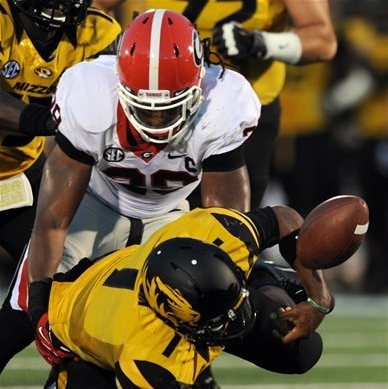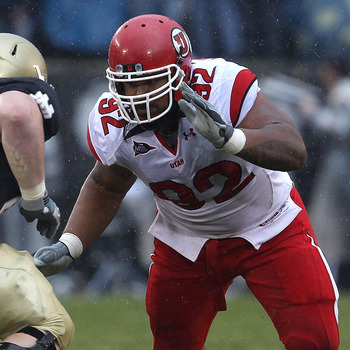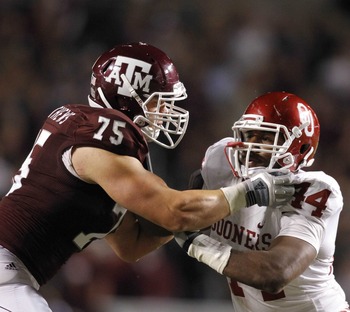
Robert Woods had a big day for USC against Syracuse
If anyone wants to know just how good Russell Wilson is, just look at tonight’s Wisconsin-Oregon State game. Last year the Badgers would’ve been in the National Championship but for two freak hail mary plays against Michigan State and Ohio State. This year, they were held scoreless against the Beavers until late in the fourth quarter and lost 10-7. The ineffective play of Montee Ball is a concern. A potential first round pick last year, Ball is suffering in the post-Wilson era due to a reduced threat in the passing game. He had 15 carries for 60 yards and no touchdowns today, with a further 18 yards receiving. His decision to return already looks like a professional error.
One man who certainly won’t be regretting his decision to return is Matt Barkley. He had no chance of supplanting Andrew Luck as the #1 pick in 2012, but he’s almost certainly destined to be the top pick in 2013. I think the Miami Dolphins will ‘earn’ the #1 pick in 2013 and they’ll either trade the pick and stick by Ryan Tannehill or draft Barkley. Even on a relatively unspectacular day against Syracuse he had six touchdowns.
Robert Woods remains an intriguing prospect at receiver. In many ways he looks like a future playmaker in the NFL. Today he caught ten passes for 93 yards, scoring two touchdowns. The first (click here to see it) was down to a precise double-move down the right hand side, a perfect pass from Barkley and perfect execution. For the second (click here) he did well to compete over the middle to grab a four-yard score. He was permanently involved and avoided mistakes, adding a brilliant 76-yard run on an end-around (click here) in the fourth quarter to set up the game ending score. During the run he made two sharp cuts to break away, drawing flashbacks to his freshman year with the Trojans.
On the one hand, Woods is such a difficult player to cover. He runs good routes and creates separation. He is capable of making circus catches and he’ll lay himself out to make a difficult completion. He has YAC potential and he’s probably at his most effective getting the ball in space quickly and using his athleticism. Then there are some issues – he’s not overly physical and may struggle in press coverage. He’s not a great blocker by any stretch, lacks ideal size (6-1, 195lbs) and you’re not going to be throwing many fades or jump balls to the guy. Seattle needs a reliable red zone receiver but Woods doesn’t look like the answer. He is liable to lose concentration at times and have a few drops, although we didn’t see that this week.
I think his final grade could be comparable to A.J. Jenkins – drafted 31st overall in April by San Francisco. At the same time he’s a much higher profile player than Jenkins and a better playmaker with superior production, so he should go a bit earlier – perhaps into the range Kendall Wright was taken (20th overall). Is he the type of receiver Seattle is looking for? This is the question I’m battling with right now. Is he too much of a Doug Baldwin-type and not enough like the big, physical receiver they’ve coveted for a while (Brandon Marshall, Vincent Jackson, Sidney Rice etc)? Can he fill the need for a true downfield passing threat? I’m going to do a piece on Da’Rick Rogers this week, a player who fits the bill in terms of size and downfield speed but has serious off-field concerns and recently transferred from Tennessee to Tennessee Tech.
Back to Barkley… He went about his business despite a clumsy game by Lane Kiffin. There wasn’t much fluidity or variety to the play calling – of Barkley’s 23 completed passes, 21 went to Woods or Marqise Lee. His six scores were all perfectly executed even if he didn’t put up the big yardage (186 yards). He did have one disappointing error for his first turnovers of the year – a pass thrown behind Woods that was easily picked off. It was a minor problem compared to the touchdowns and he looks on cue for a real tilt at the Heisman.
Some other notes from this game – USC center Khaled Holmes, a legit pro-prospect, went down with a bad looking injury in the fourth quarter after getting caught in a crowd of bodies. It appeared to be an ankle problem. He could be take in the first three rounds next year. Syracuse quarter Ryan Nassib did little to boost his stock. He was a hot-tip among scouts this week after a good performance against Northwestern. However, he had two turnovers (click here to see the first) and a very poor first half. His footwork is poor and needs serious work, and he was off-target on too many passes. Technically he has some positives but he’s not a stand-out athlete – he’s almost like a much less spectacular version of Barkley. I would guess he’s at best a mid-round pick next April.
Jarvis Jones was superb against Missouri. In fact, superb isn’t a strong enough word to describe how well he played. He should be given week 2 and week 3 player of the week for his stunning performance. It shouldn’t be a surprise by now – Jones is clearly the best overall defensive prospect who is eligible for the 2013 draft. He provided consistent pressure off the edge and Missouri just couldn’t block the guy. He had multiple sacks, two key forced fumbles in the second quarter, a third in the final quarter and multiples pressures. He’s not the biggest guy and he doesn’t appear to have long arms – that’s why it’s all the more impressive to see how he avoids blockers – they struggle to get hold of him because he’s too quick with great hands. Jones can round the edge with such burst, he’ll also fight inside. He’s a relentless pass rusher and there’s very little he can’t do. He essentially sealed the game for Georgia with a big interception in the 4th quarter, dropping into coverage. We won’t see a defensive player match this performance in 2012. If the Seahawks get a chance to draft this guy, they should take it. They’ll have to be 4-12 bad for that to happen.
Nose tackle John Jenkins was also very impressive – he’s one I’ll do a feature on down the line.
Star Lotulelei isn’t showing much improvement from last year. He had a sack/forced fumble during Utah’s 27-20 loss to Utah State on Friday, but he’s still very inconsistent. As a pure physical specimen he’s an elite talent – he moves so well for a big man. The way he sprints from the LOS to the sideline is reminiscent of Phil Taylor during his time at Baylor, who was vastly underrated as a college prospect. At times he’ll shoot a gap and penetrate better than any other tackle you’ll watch this year. He has a good initial burst, good hand placement and he’ll finish. But on the next play, there’s every chance he’ll be blown up.
I’ve seen numerous occasions where Loutlelei has been a liability in run defense. He’s too easily moved out of position when he needs to hold. It’s ugly too – he’ll lose balance and get driven backwards. Lotulelei has about as much potential as anyone eligible for 2013 and for that reason he’s almost a shoe-in to be a top-15 pick – look at Dontari Poe. But he can’t be satisfied with just being an early pick. To make the most of his potential at the next level, he needs to do a lot of work on his technique and consistency to become a rounded prospect that can feature every down and not just on pass rushing calls. He has a way to go and the gushing praise he receives nationally needs to be checked slightly.
A more consistent defensive tackle with less overall potential – Sylvester Williams at UNC – continued his good start to the season with another sack in a 28-27 defeat to Wake Forest. Williams has three sacks in the opening two weeks of the season. You can see his sheer power and athleticism on today’s sack, driving two blockers into the quarterback to make the play. Williams is an exciting player to watch and could be a high pick in April.
Jonathan Banks – the kind of cornerback Seattle has drafted under Pete Carroll and John Schneider at 6-2 and 185lbs– had two interceptions for Mississippi State against Auburn (interception one, two). He also had two passes deflected. We’ll have tape of Banks’ performance on the blog soon.
Keenan Allen had five catches for 69 yards and a touchdown as California beat Southern Utah 50-31. He’s never going to put up big yards because of the quarterback situation at Cal. Allen needs to keep things ticking over and then impress at the combine. Allen also had a 69-yard punt return for a score today, which he initially fumbled.
DeAndre Hopkins had another big game for Clemson against Ball State. Last week he set a school record for receptions in a game, and today he had six more catches for 105 yards and three touchdowns including this 34-yarder. He’s emerging as a reliable target for Tajh Boyd. Running back Andre Ellington was less spectacular this week. He punched in two touchdowns but only managed 41 yards from 13 carries.
A lot of people expected Washington State to put up big numbers with Mike Leach in town, but it’s not happening so far. In particular receiver Marquess Wilson is off to a slow start. He had four catches for 61 yards against BYU last week and had only four catches for 47 yards against Eastern Washington today. He has zero touchdowns so far.
Justin Hunter had a better weekend. Teammate Cordarrelle Patterson won the headlines last week against NC State, but Hunter put up the big numbers against Georgia State. He recorded eight catches for 146 yards and three touchdowns (touchdown one, two, three). Patterson had three catches for 71 yards (including a long of 45 – click here) while adding 18 rushing yards. Tyler Bray looked sharp completing 18/20 for 310 yards and four touchdowns. Bray could be this year’s answer to Brock Osweiler. Patterson’s YAC ability and downfield threat will make him one of the most talked about receivers in the SEC. He’s raw, but has huge upside.
Tyler Wilson started poorly for Arkansas against L-A Monroe, throwing a pick and missing on a few throws. He responded to make 11/20 for 196 yards and two scores before leaving the game at half time with a concussion. It proved costly – Arkansas (ranked #8) were stunningly defeated in over time. They led 21-7 before Wilson’s exit. Landry Jones also started slowly for Oklahoma against Florida A&M by throwing a pick. Jones left the game in the second half with the Sooners comfortably leading having thrown two touchdowns for 252 yards. There was a bit of a trend for bad starts among quarterbacks this week (Barkley, Nassib, Wilson, Jones, Aaron Murray).




































